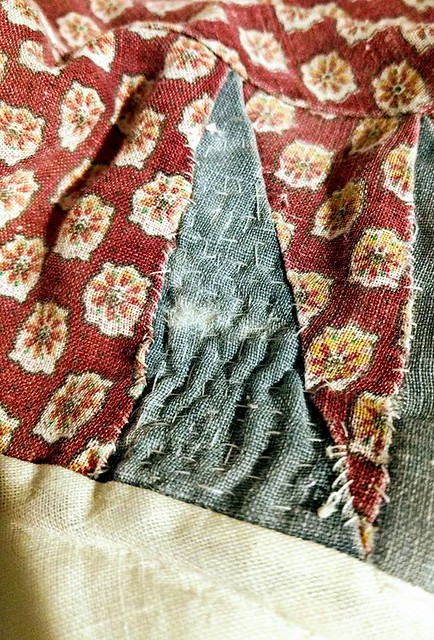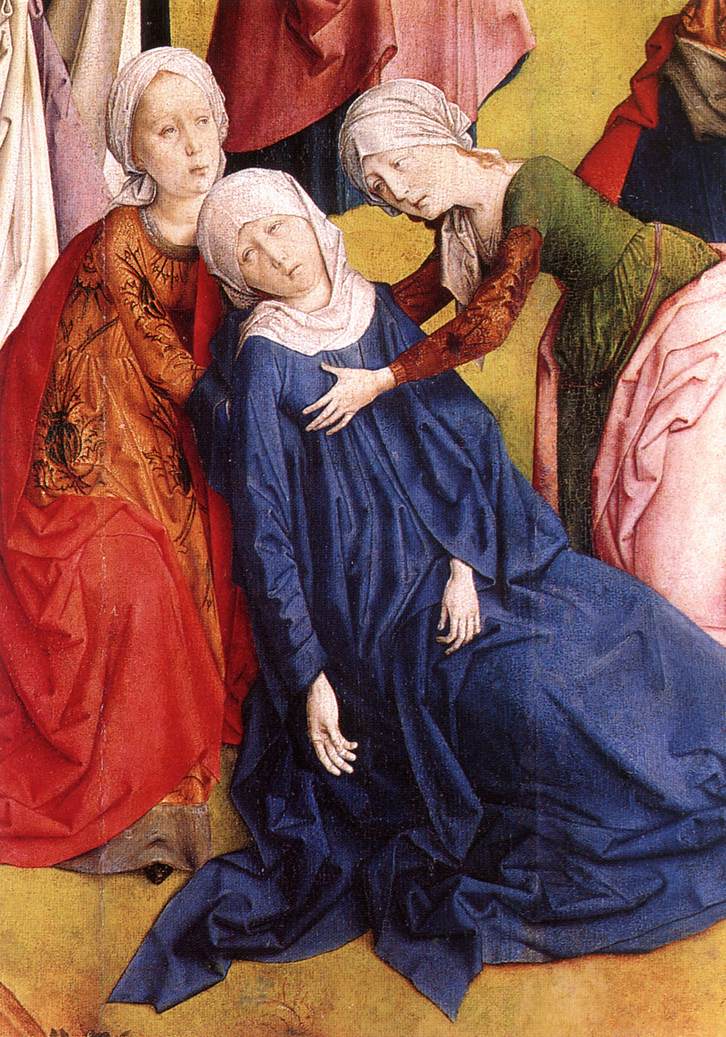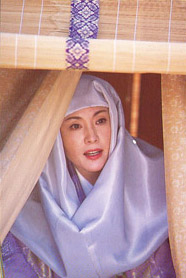Cool winter evening
The fire-flowers blossom
One by one, they bloom
In my heart, an ember burns
Hope, glowing, warming my soul
(Fireworks in the New Year)
Cool winter evening
The fire-flowers blossom
One by one, they bloom
In my heart, an ember burns
Hope, glowing, warming my soul
(Fireworks in the New Year)
Of possible interest to poetry enthusiasts: Christopher Kern, a visiting professor at Auburn University, is in the process of translating the Gosenshū (Gosen Wakashu), collected about 951 CE, which was the 2nd of the great Imperial Anthologies. He has put up a Wiki with what he has so far, including sources used and analysis of the poems. Check it out here: http://jchristopherkern.com/Wiki/Gosen_wakashu
There is a short wikipedia entry about the Gosenshū here: https://en.wikipedia.org/wiki/Gosen_Wakash%C5%AB
And a brief entry concerning the 21 Imperial Anthologies here: https://en.wikipedia.org/wiki/Chokusen_wakash%C5%AB#Nij%C5%ABichidaish%C5%AB

The canvas-weight shibori patterned material that I am taking apart to repurpose. Tried to make a kosode from it, but it is too thick and scratchy, and lining it would make it too warm. So it will be made into something else, probably some kind of carrying bags. I got the material cheap when Hancock’s went out of business, $11 for 9 yards.
Day 4 of 100 Days of Arts and Sciences. Soprano recorder practice, more on the kanji radicals workbook, shodo practice, pulled together some of my Japanese doll research to answer a question on SCA Japanese FB page.
Day 5 of 100 Days of Arts and Sciences. Practiced tenor recorder, wrote a couple of tanka, did some Japanese clothing research.
Day 6 of 100 Days of Arts and Sciences. Practiced soprano recorder, went to Shodo lesson, made progress on Class prep for RUSH, fell down research hole about how lower-class Japanese patched/repaired clothing. Mostly 19th and early 20th century information, but can certainly tie literary references to the practice (regrettably vague), but some Shōsō-in garments show this kind of patching or similar. Worth digging more into. Next few days will be slow, have some Real Life constraints on my time, but should be able to do something, even small!
Day 7 of 100 Days of Arts and Sciences. Nursing a migraine today, so just did some hand-sewing repair on a cloak and some zukin where threads had come loose. Took apart a trial kosode I made from some shibori-designed fabric I picked up on clearance when Hancock’s closed. Thought it might work for garb. It looks right but it is almost canvas weight and would be too hot and scratchy. Will probably repurpose the material to make bags or something like that instead. Waste not, want not.

First attempt at using Japanese boro stitching technique to fix a frayed area on a quilt. Simple running stitch used in period. Not complete success. Need more even stitches, probably slap a patch over the area and then try running stitch and see how that goes. Just experimenting on an idea.
Day 8 of 100 Days of Arts and Sciences. Wrote two tanka and a haiku, more reading on Japanese work clothes, soprano recorder practice, sourcing materials for my RUSH classes (and trying to remember where I stashed those student brushes–I’ve given some away but I know I have more.) I need to fit in some time tomorrow to get that kosode sloper put together so I can see if my updated pattern works. #somedayiwillbeorganized #todayisnotthatday
Day 9 of 100 Days of Arts and Sciences. Still gathering materials for RUSH classes, continued reading book on Japanese work clothes, and taking apart failed canvas shibori kosode to reuse material.
Day 10 of 100 Days of Arts and Sciences. Updated SCA blog, finished reading book on Japanese work clothes, finished taking apart shibori kosode (fabric will be stored an be reworked into carrying bags later, after I get more clothing sewn!).
The book I’ve been reading about Japanese work clothes is Stories Clothes Tell: Voices of Working Class Japan by Horikiri Tatsuichi, translated by Reiko Wagoner. ISBN 1442265108 (ISBN13: 9781442265103). The author spent decades traveling around Japan and collecting examples of working-class clothing, mostly from the Meiji, Taisho, and early Showa era. (So he focused roughly 1868 to the early 1960’s in time period.) This book is a translation of several essays that Horikiri wrote concerning items from this collection. While he tends to go a little far in conjecture about items, the small details about these work clothes and how they were used is a fascinating read, if a bit melancholy since some of these stories really bring into focus how desperately poor these people were.
There are more “social histories” now than there used to be, that focus on the lives of the common people. Since the time period this book focused on was post-1600, many items he discussed were not exactly applicable to SCA, but his approach is certainly one we can apply. It was remarkable to see how slowly the clothing evolved in usage–Horikiri discusses the evolution of some of the items from Edo-period clothing. With a little work, some items might be placed before that. It would take looking at visual sources and perhaps literature, since no extant pieces would exist.
The book was also useful in isolating some Japanese terms regarding fabric and clothing and includes a glossary, although most of the items mentioned are Edo-period or later. Still, there is some hidden treasure here. In one essay, he speaks of the difference between the rough-woven asa 大麻(hemp) cloth used by the lower classes, and the finer-woven joufu 上布, which seemed to be linen or perhaps a mix of hemp and linen? Definitely of a much tighter weave, and according to this Japanese wikipedia article on 上布, there are some extant pre-1600 examples of joufu?
Anyway, it looks like it would be worthwhile to track down more of these specific terms, not often referenced in English language sources!

There was a question on the SCA FB page regarding kyoji karuta (competitive matching-type card play). Since this was an area that I’d looked into a while back, here was my answer. Short form: karuta as an item appeared in Japan in the 16th century, but matching-type karuta games are an Edo-period development and do not fall within the pre-1600 guidelines set by the SCA
I did some research into this area a while back. The kai-awase (matching shells) is very much within the timeframe that the SCA covers. While karuta (which is a word based upon Portuguese for carta “card”) definitely came in during the 16th century, they were mostly used for European-style card playing and gambling–in fact, there seems to have been a book published in 1597 with rules for various gambling-type games. Karuta did start to be domestically made by the end of the 16th century but followed the design of European decks. The various matching games and uta-karuta developed in the Edo period, while kyogi karuta came about in the 19th century. So please keep in mind that, while amusing, kyoji karuta is not period. Here’s a good page (in Japanese) that explains the history of karuta very well.
Edo Karuta page: very good outline of the history of karuta. This is where I found the reference to the book written in 1597 called 博奕かるた諸勝負令停止, which from the kanji seems to be rules about gambling with karuta. Page is in Japanese.
Miike Karuta Museum’s page about karuta history. The museum is in Omuta, Fukuoka Prefecture, an area where a lot of the domestic Japanese karuta cards were made. It houses the most complete historical collection of Japanese karuta.
Wikipedia can be an iffy source, but in this case, the entry about karuta is thorough and has a lot of cites to follow.
(Image saved from an Ebay listing of uta-karuta cards. Yes, I have a set.)

Woman writing letter at desk (c.1940s). Henry Clive (Australian, 1882-1960).
I have decided to do Nanowrimo again this year, as I do every year. Even though I haven’t ever managed to hit the word count, Nanowrimo has helped me generate some good bases for stories or write a good stack of poems. I just seem to write short stories better than novels, but novels are what people want. And yes, I’ll miss a week, but I’m going to attend a few of the write-ins in the area and maybe meet some new folks.
Anyway, I have an idea and a name “Ephemeroptera”. It’s a horror story. That’s about all I’ll say for now.
Yes, I still plan to do the Tanka Challenge. I want to finish my first batch of 100 linked poems. I’ve done 83 so far. The Tanka Challenge should finish the batch. Hyakushu (100 poem linked sequence) is way more challenging than stand-alone tanka, and honestly, it’s been hard to tap into my inner elegant courtier when surrounded by the ugliness of our current government. Every day brings a new horror. But I’ve been reading a biography of the poet Fujiwara no Sadaie (Teika), as well as a biography of the poet Shinkei, who lived about 150 years after Teika. I also have access to some poetic treatises written by both these poets, as well as one from a disciple of Shotetsu.
What interests me about both of these men is that they lived during turbulent times. Teika lived and wrote during the end of the Heian period and the beginning of the Kamakura period. Shinkei lost his home during the Onin Wars. Yet they produced some of the most stirring poetry of the Japanese middle ages. I want to read their poems and their thoughts and see how they did what they did, and whether it can be accomplished in English.
This project will take time, since there is a wealth of source material available (in English!), but it’s an avenue I would like to explore.
Stumbled on an awesome find today. It’s a list of Pre-modern Japanese texts and what translations (if any) have been done. Dated 2013, but it looks like they are trying to keep it updated. So if you are trying to track down a particular early Japanese primary source, this can tell you if it has been translated and where you can find said translation.
You can find it here: Pre-modern Japanese Texts and Translations.
Note: It is a bibliography, so the translations are not hosted. They try to link to articles and such, but how this helps is finding out if some of these primary sources have been translated into English (or other western languages) and finding out where those translations can be found.

Blossoming orchard
Humble apple trees preening
For once in beauty
Welcoming soft spring rain like
An innocent girl in love
Link: orchard in blossom to blossoming orchard
I chose apple trees because they are commonly seen in the Midwest and when we lived in Iowa, we lived near an orchard. Kigo 季語 in Japanese poetry are words and phrases associated with seasons. They are often gathered in collections called saijiki 歳時記. However, because the climate where I live in Kansas is far different from that of Japan, I sometimes choose kigo that apply to what I see in my everyday life. The most common flowering trees that were used in medieval tanka were the plum (early spring) and the sakura (middle spring).
Apples actually were not widely cultivated in Japan until the Meiji period (1868-1912), although they are quite popular there now. Here is an interesting list about some Japanese fruits and when they were first cultivated there.
Due to the popularity of the haiku form of poetry, there are some saijiki lists online for English speakers. There is a good one heretranslated by William J. Higginson that focuses on Japanese kigo. There is also an interesting one here called the World Kigo Dictionary that has links to lists for kigo in other parts of the world. However, while they have some for North America, there doesn’t seem to be one specifically for the Midwest. (One for Oklahoma, though, and one for the Northern prairie–but from the descriptions I was reading, that sounds like Minnesota or the Dakotas? Not quite the same thing as here.) There are a number of other lists online as well.
However, while kigo developed out of tanka poetry, some of the traditions were established in the Edo period and are particular to haiku, so if you are writing tanka for SCA (medieval reenactment) purposes, double-check.
Painting by John Everett Millais 1859. (c) Lady Lever Art Gallery; Supplied by The Public Catalogue Foundation
A question was asked on the SCA Japanese Facebook page: “Padded Uchigi. Is this just, like, quilted? fluffy? Essentially really thick interfacing? I assume they used silk, but I can’t envision what the final product looks like.”
My answer:
真綿 (mawata) is low-quality silk, nowadays mostly used for making handkerchiefs, but was used for padding on winter garments. This page shows what it looks like: http://www.wildfibres.co.uk/html/mulberry_silk.html
“Was it just stuffed in or how did it stay in place?”
John Marshall actually has a chapter about it in his _Make Your Own Japanese Clothes_, where he discusses the traditional method and then a more modern method better suited towards modern washing using easier to find material (since his book IS about modern clothes). Mawata is sticky, so you basically layer it in place. This webpage shows the process for silk handkerchiefs–it is just on a larger scale for garments. http://www.wormspit.com/mawatas.htm
Marshall, John. Make Your Own Japanese Clothes (Tokyo; Kodansha International, 2013 reprint) 978-1568364933. Originally printed in 1988, ISBN 087011865X.
I signed up to do an outfit for a project that one of my fellow Calontiri, Cecilia, is doing: she is creating photographic portraits recreating the illuminations in Richard Tessard’s version of Boccaccio’s “The Lives of Famous Women”. You can see the pictures on this Pinterest page. My first two choices were already taken, but I settled on the portrait of Cornificia, who was a 1st century BC Roman poet. The dress is plain compared to some of the others, so I think I can manage it, plus with that pose and the cloak, it won’t matter that I’m so fat.
Boccaccio writes of her that “She was equal in glory to her brother Cornificius, who was a much renowned poet at that time. Not satisfied with excelling in such a splendid art, inspired by the sacred Muses, she rejected the distaff and turned her hands, skilled in the use of the quill, to writing Heliconian verses… With her genius and labor she rose above her sex, and with her splendid work she acquired a perpetual fame.” Her work is lost, but St. Jerome mentions her in his chronicles in 4th century AD, so her work was good enough that it was being read 400 years after her death, and by St. Jerome to boot, who was not an easy man to please.
Here is the picture she will be recreating:

Although color substitutions are being allowed, I think I already have linen in both that blue and the light purple. The tight sleeves look like those of a Gothic fitted dress, but those gathers in front resemble a houppelande? But those tend to have big or hanging sleeves and women mostly wear those belted. This dress is NOT belted. It might be some kind of loose gown?
There’s a similar dress on the Blessed Virgin Mary in The Calvary Triptych by Hugo van der Goes (@1468). Sleeves are a bit different, but the shape of the dress looks similar.

Here’s another example by van der Goes from the Monforte alterpiece. He puts the Virgin Mary in this same style of dress consistently.

So anyway, have some research to do. I’m going to try to finish this outfit by December, 2017. I will be making the dress, underdress, veil, and shoes (unseen in picture).
Here is a link to my Queen’s Prize Entry for 2016, which looks at zukin (hoods), often worn by Buddhist monks and nuns, but also, it turns out, by others, mostly from the lower classes. Format is PDF.

Woman wearing a sode-zukin from the NHK taiga drama “Yoshitsune”.
The paper is at this link: An Examination of Zukin